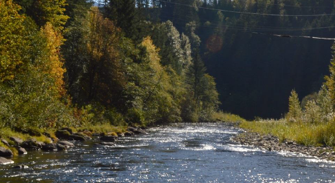Cold-water Safe Havens for Fish
- June 18, 2020
- John Harrison

Twelve tributary rivers of the Columbia have average water temperatures cool enough to qualify as refuges for salmon and steelhead under Oregon’s state water temperature guidelines, an official of the Environmental Protection Agency told the Council at its June meeting. All of them are downstream of John Day Dam, leaving the 77-mile stretch of river from that dam to McNary Dam potentially dangerously warm for the fish.
The 12 tributaries, which are on both the Washington and Oregon sides of the river, are among 23 tributaries the EPA has identified as cold-water refuges for adult salmon and steelhead returning from the ocean to spawn in the late spring and summer, when Columbia River temperatures rise along with the seasonally warm weather. Oregon’s standard for cold-water refuges is an average water temperature that is two degrees Celsius cooler than the mainstem Columbia. Protecting and restoring cold-water refuges is important for the survival of migrating salmon and steelhead and the recovery of future populations.
In a presentation to the Council, John Palmer, senior water policy advisor for Region 10 of the EPA, said the agency’s research has shown that, currently, migrating fish that use the available cold-water refuges are summer steelhead and fall Chinook. In a typical August and September, 60,000-70,000 summer steelhead pull out of the mainstem to rest in the lower reaches of the colder tributaries. Fall Chinook also use the tributary refuges, but not as many – about 5,000 during the same time period.
The EPA released a Draft Cold Water Refuges (CWR) Plan in October2019. The plan focuses on the Lower Columbia River from the mouth of the Snake River to the ocean. The plan uses Oregon’s water quality temperature standard of 20 degrees Celsius (68 degrees Fahrenheit) and calls for “sufficiently distributed” cold-water refuges, or resting places for adult fish, to aid their migration. The refuges must have water temperatures that are at least 2 degrees Celsius cooler than the main Columbia channel. The plan responds to EPA’s obligation under the Endangered Species Act to protect ESA-listed species of salmon and steelhead.

Palmer said fish use of cold-water tributaries for resting on their migration journey has increased over time, as the river has warmed. In the 1950s, there were only about 10 days of the year when the Columbia was warmer than 21 degrees Celsius, but now there are 57 days above 20 degrees and 27 days above 21 degrees in an average year. On average, the river today is about 2 degrees Celsius warmer than in the 1950s, he said.
The temperature limit for salmon and steelhead is considered to be 21 degrees. Exposure to water over 21 degrees for long periods can be lethal, as was shown in the summer of 2015 when a quarter million July-migrating sockeye died in the inhospitably warm Columbia between Bonneville and McNary dams.
“Climate change has baked in a [migration] delay in August and will continue to change and increase cold-water refuge use in the future,” Palmer said.
Actions in the draft plan to protect and enhance cold-water refuges include restoring stream vegetation; improving channel complexity; removing built-up sediment from the mouths of some tributaries; releasing cold water from tributary dams; and improving floodplain function and summer flows in target reaches. Some of the projects are the types of habitat improvements implemented through the Council’s Columbia River Basin Fish and Wildlife Program and funded and managed by the Bonneville Power Administration.
The goal of the plan, Palmer said, is to counteract predicted temperature increases from climate change. The plan notes the importance of the Deschutes and Umatilla rivers, as both are prone to warm water and both are used, and could be used more frequently, by migrating fish. The plan also notes the possibility of using groundwater to create a cold-water refuge in Lake Umatilla, the reservoir behind John Day Dam.
The cold-water refuges plan is the basis for the cold-water targets in the EPA’s May 2020 Columbia/Snake River Temperature TMDL (Total Maximum Daily Load) standard in the lower Snake and Columbia rivers, Palmer said. A TMDL is a calculation that identifies the amount of a pollutant (in this case, heat) that a river or other waterbody can receive and still meet specific standards, such as standards for fish survival. Palmer said the EPA plans to finalize the cold-water refuges plan after the comment period on the TMDL document ends on July 21.



